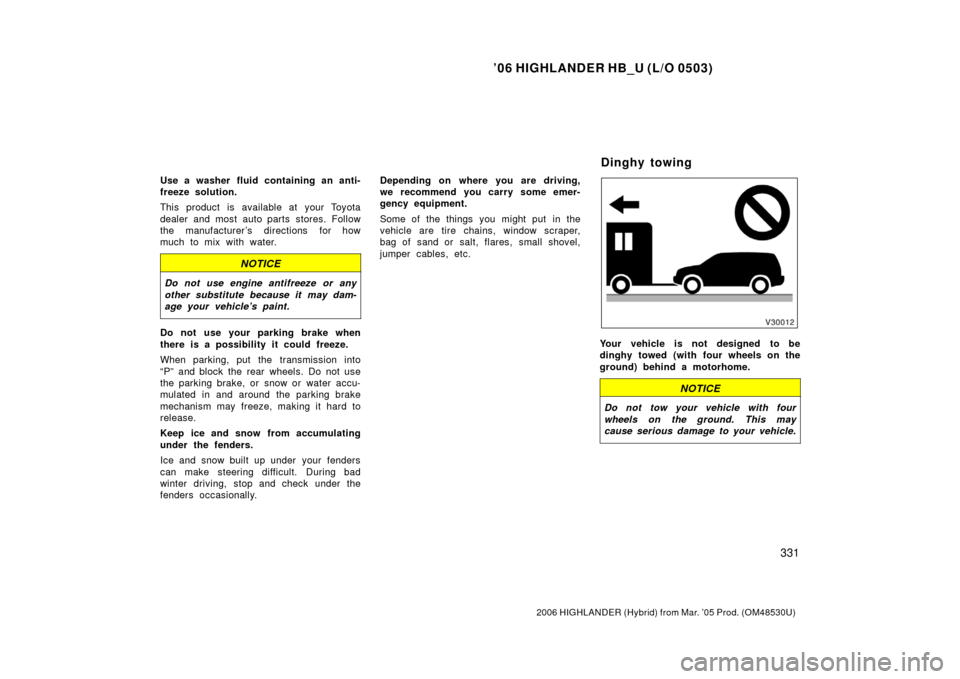Page 343 of 436

’06 HIGHLANDER HB_U (L/O 0503)
331
2006 HIGHLANDER (Hybrid) from Mar. ’05 Prod. (OM48530U)
Use a washer fluid containing an anti-
freeze solution.
This product is available at your Toyota
dealer and most auto parts stores. Follow
the manufacturer ’s directions for how
much to mix with water.
NOTICE
Do not use engine antifreeze or any
other substitute because it may dam-
age your vehicle’s paint.
Do not use your parking brake when
there is a possibility it could freeze.
When parking, put the transmission into
“P” and block the rear wheels. Do not use
the parking brake, or snow or water accu-
mulated in and around the parking brake
mechanism may freeze, making it hard to
release.
Keep ice and snow from accumulating
under the fenders.
Ice and snow built up under your fenders
can make steering difficult. During bad
winter driving, stop and check under the
fenders occasionally. Depending on where you are driving,
we recommend you carry some emer-
gency equipment.
Some of the things you might put in the
vehicle are tire chains, window scraper,
bag of sand or salt, flares, small shovel,
jumper cables, etc.Your vehicle is not designed to be
dinghy towed (with four wheels on the
ground) behind a motorhome.
NOTICE
Do not tow your vehicle with four
wheels on the ground. This may
cause serious damage to your vehicle.
Dinghy towing
Page 353 of 436

’06 HIGHLANDER HB_U (L/O 0503)
341
2006 HIGHLANDER (Hybrid) from Mar. ’05 Prod. (OM48530U)
�If you should accidentally get acid
on yourself or in your eyes, remove
any contaminated clothing and flush
the affected area with water im-
mediately. Then get immediate medi-
cal attention. If possible, continue
to apply water with a sponge or
cloth while en route to the medical
office.
�The gas normally produced by a
battery will explode if a flame or
spark is brought near. Use only
standardized jumper cables and do
not smoke or light a match while
jump starting.
NOTICE
The battery used for boosting must
be 12 V. Do not jump start unless you
are sure that the booster battery is
correct.
JUMP STARTING PROCEDURE
1. If the booster battery is installed in another vehicle, make sure the vehicles
are not touching. Turn off all unneces-
sary lights and accessories.
When boosting, use the battery of
matching or higher quality. Any other
battery may be difficult to jump start
with.
If jump starting is difficult, charge the
battery for several minutes.
2. If required, remove all the vent plugs from the booster and discharged batter-
ies. Lay a cloth over the open vents
on the batteries. (This helps reduce the
explosion hazard, personal injuries and
burns.)
3. If the engine in the vehicle with the booster battery is not running, start it
and let it run for a few minutes. During
jump starting, run the engine at about
2000 rpm with the accelerator pedal
lightly depressed.
Discharged
battery
Booster
battery
Positive
terminal
(“+” mark) Jumper cable Positive terminal
(“+”mark)
4. Make the cable connections in the or-
der a, b, c, d.
a. Connect the clamp of the positive
(red) jumper cable to the positive (+)
terminal of the discharged auxiliary bat-
tery.
b. Connect the clamp at the other end
of the positive (red) jumper cable to
the positive (+) terminal of the booster
battery.
Page 354 of 436

’06 HIGHLANDER HB_U (L/O 0503)
342
2006 HIGHLANDER (Hybrid) from Mar. ’05 Prod. (OM48530U)
Jumper cable
Booster
battery
Discharged
battery
Negative terminal
(“− ”mark)
c. Connect the clamp of the negative
(black) jumper cable to the negative ( −)
terminal of the booster battery.
d. Connect the clamp at the other end
of the negative (black) cable to a solid,
stationary, unpainted metallic point
away from the auxiliary battery (such
as shown in the illustration). Do not
connect it to or near any part that may
move when the hybrid system is star-
ted.The recommended connecting points
are shown in the illustration.
CAUTION
When making the connections, to
avoid serious injury, do not lean over
the battery or accidentally let the
jumper cables or clamps touch any-
thing except the correct battery termi-
nals or the ground.
5. Start the hybrid system. Make sure the “READY” light is on.
If the traction battery warning light
comes on in the meter cluster, the
traction battery is also discharged. In
this condition, the hybrid system will
not start. Contact your Toyota dealer.
6. Carefully disconnect the cables in the exact reverse order: the negative cable
and then the positive cable.
7. Carefully dispose of the battery cover cloths—they may now contain sulfuric
acid.
8. If removed, replace all the battery vent plugs.
If the cause of the auxiliary battery dis-
charging is not apparent (for example,
lights left on), have the battery checked
by your Toyota dealer.
If the first start attempt is not success-
ful...
Check that the clamp on the jumper
cables are tight. Recharge the discharged
battery with the jumper cables connected
for several minutes and restart the hybrid
system in the normal way.
If the another attempt is not successful,
the battery may be depleted. Have it ch-
ecked at your Toyota dealer.